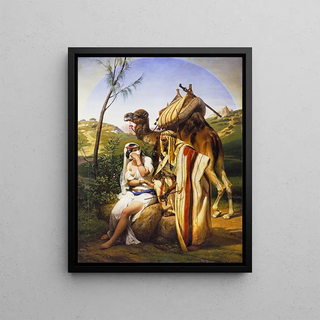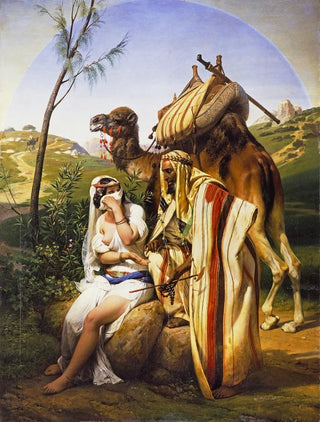Art print | Juda and Tamar - Horace Vernet


View from behind

Frame (optional)
The artwork "Juda et Tamar" by Horace Vernet, created in the 19th century, is a masterpiece that immerses the viewer in a biblical scene rich in emotion and drama. Inspired by the Genesis story, this depiction illustrates the moment when Judah, the patriarch, confronts Tamar, his daughter-in-law, in a tense and passionate context. Vernet, with his undeniable talent, manages to capture not only the intensity of the moment but also the complexity of human relationships. Through this piece, the artist invites us to explore themes of morality, justice, and redemption, while revealing the psychological depth of the characters.
Style and uniqueness of the work
Vernet's style is characterized by striking realism, combined with a romantic sensitivity that brings his characters to life. In "Juda et Tamar," the meticulous details of the clothing, facial expressions, and body dynamics demonstrate exceptional technical mastery. Light plays a crucial role in this composition, highlighting the features of the characters while creating a dramatic atmosphere. Vernet uses warm colors and deep shadows to enhance the emotional intensity of the scene. The way he manages to balance movement and serenity in this piece is a true feat, offering the viewer a complete immersion into the story. Every element, from the setting to the postures, is carefully orchestrated to evoke a story that transcends time.
The artist and his influence
Horace Vernet, born in 1789 in Paris, is one of the most emblematic artists of the French Romantic movement. Son of the painter Carle Vernet, he forged a unique identity, blending academic tradition with innovation. Vernet is renowned for his battle scenes, but he also excels in depicting historical and mythological subjects. His influence extends beyond his era, inspiring many artists who sought to capture moments of truth and emotion. Through "Juda et Tamar," one can feel the imprint of his genius, capable of transforming ancient stories into contemporary reflections on the human condition. His work has contributed

Matte finish

View from behind

Frame (optional)
The artwork "Juda et Tamar" by Horace Vernet, created in the 19th century, is a masterpiece that immerses the viewer in a biblical scene rich in emotion and drama. Inspired by the Genesis story, this depiction illustrates the moment when Judah, the patriarch, confronts Tamar, his daughter-in-law, in a tense and passionate context. Vernet, with his undeniable talent, manages to capture not only the intensity of the moment but also the complexity of human relationships. Through this piece, the artist invites us to explore themes of morality, justice, and redemption, while revealing the psychological depth of the characters.
Style and uniqueness of the work
Vernet's style is characterized by striking realism, combined with a romantic sensitivity that brings his characters to life. In "Juda et Tamar," the meticulous details of the clothing, facial expressions, and body dynamics demonstrate exceptional technical mastery. Light plays a crucial role in this composition, highlighting the features of the characters while creating a dramatic atmosphere. Vernet uses warm colors and deep shadows to enhance the emotional intensity of the scene. The way he manages to balance movement and serenity in this piece is a true feat, offering the viewer a complete immersion into the story. Every element, from the setting to the postures, is carefully orchestrated to evoke a story that transcends time.
The artist and his influence
Horace Vernet, born in 1789 in Paris, is one of the most emblematic artists of the French Romantic movement. Son of the painter Carle Vernet, he forged a unique identity, blending academic tradition with innovation. Vernet is renowned for his battle scenes, but he also excels in depicting historical and mythological subjects. His influence extends beyond his era, inspiring many artists who sought to capture moments of truth and emotion. Through "Juda et Tamar," one can feel the imprint of his genius, capable of transforming ancient stories into contemporary reflections on the human condition. His work has contributed






